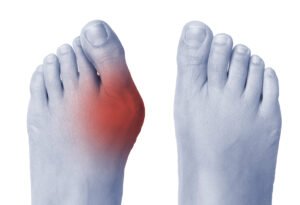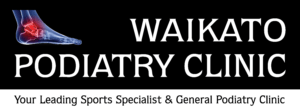Bunions – We can Help!
What is a Bunion?

A bunion (Hallux Abductovalgus) or a bony prominence at the great toe joint, is a deformity that can often lead to difficulty with footwear as well as pain from osteoarthritis and a slow dislocation of the joint. This condition presents as a deviation of the angle within the big toe and the ball of the foot. This is more common in women, the ratio as high as 9:1 for women compared to men.
How do I know if I have a bunion?
Take a look at your feet; your big toe should point straightforward and form a nearly straight line with the heel. If the big toe seems crooked and there is a bump towards the inside part of the foot, near the base of the toe, then you probably have a bunion. Our trained specialists can diagnose this properly for you. Often an advanced bunion will cause other foot and digital complications because of pressure and crowding, as mentioned in ‘Long Term Solution’.
What causes bunions?
The causes of this condition are not exactly clear but there appears to be a strong genetic or hereditary link.
Although the use of tight shoes and high heels has been suggested to cause bunions, this is not always the case; however, the progression can be accelerated by the use of inappropriate footwear. Symptoms from bunions include inability to fit shoes, pain or stiffness at the affected joint, and inflammation including redness and swelling.
How can bunions be treated?
At Waikato Podiatry Clinic, our trained specialists can assess the extent of the deformity. In certain cases an x-ray may be undertaken to evaluate the degenerative changes. It is important for us to track the stage of the bunion using the Manchester scale.
Pain Reduction
The cause of the pain needs to be directly diagnosed; a bunion can be a direct cause, but it can cause other
areas of compression through the forefoot, which is also a big contributor. A bunion bio-mechanically alters the
foot shape, and also the loading patterns through the forefoot. This compensatory change that occurs can
often produce pain and over-use areas of the forefoot. This may or may not be associated with corns and calluses, but does tend to increase the load on the smaller, lesser joints of the forefoot. For example the second, third and fourth metatarsals, essentially destroying the transverse arch of the foot. These are best addressed with a well balanced and fitted orthotic, in an appropriate shoe. Toe devices can also be used to help reduce pain and
pressure in the forefoot, but these are many and need to be discussed in situation specifics.
Long Term Solution
 As with most conditions getting the correct diagnosis in the first place is so important. Non-operative treatments are usually implemented before any further surgical intervention is considered. Our podiatrists will assess your feet
As with most conditions getting the correct diagnosis in the first place is so important. Non-operative treatments are usually implemented before any further surgical intervention is considered. Our podiatrists will assess your feet
and make the recommendations as to how your bunions are best managed. There are four different stages of bunions in the classification system, and treatments will differ depending on what stage you’re at. Treatments often include adequate footwear, spacers, orthotic intervention and silicone gel bunion pads can be prescribed to
offload and deflect the pressure at the metatarsophalangeal joint. Joint manipulation and mobilisation and also be
used to help retain good movement in the big toe joint, as well as preventing contracture of muscles
in the forefoot. Surgical procedures are indicated when there is a chronic pain affecting your quality of life, or when
the degree of the deformity is such that it makes wearing shoes difficult, or you’re getting problems caused by crowding and through the other areas of the forefoot. Additional complications involve corns, calluses,
pressure areas, rubbing, and blisters. We can offer appropriate investigations, and x-rays can be organised to help us track the progression of the bunion.
Still in pain?
Are you feeling like you have tried everything but are still in pain?
Do you feel like you have seen every health practitioner you can about your bunion pain?
We have a track record of diagnosing and successfully treating cases that have previously proven difficult to resolve and we’d love to help you get back on your feet doing what you love.
Call us or drop us an e-mail & we’ll get back to you as soon as possible to discuss your AT pain and some possible solutions. You can also book an appointment online.
Providing the people of Waikato with a centre of podiatry excellence



Hi
I have a bunion and consulted various healthcare professionals re this . In my case it is defo hereditary as my mother had them on both feet.
Luckily I only have one on my left foot .
I am a keen walker in a club but am starting to struggle.
I have some inserts and also got some foam from a chiropodist which didnt work .
I want some advice re my next move.
1) whether to consider surgery
2) wearing suitable walking boots
3) wearing dressy shoes not too expensive for an upcoming wedding